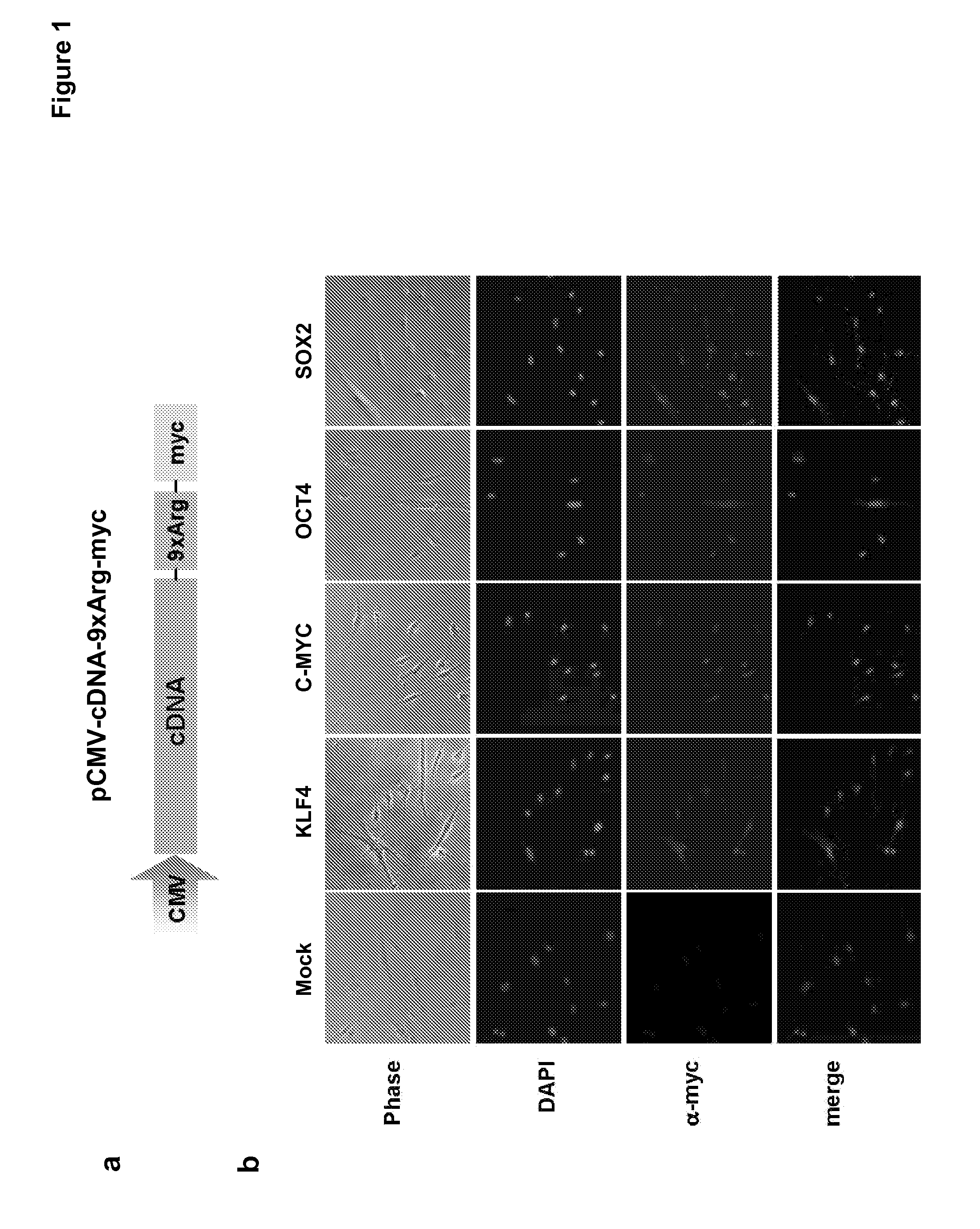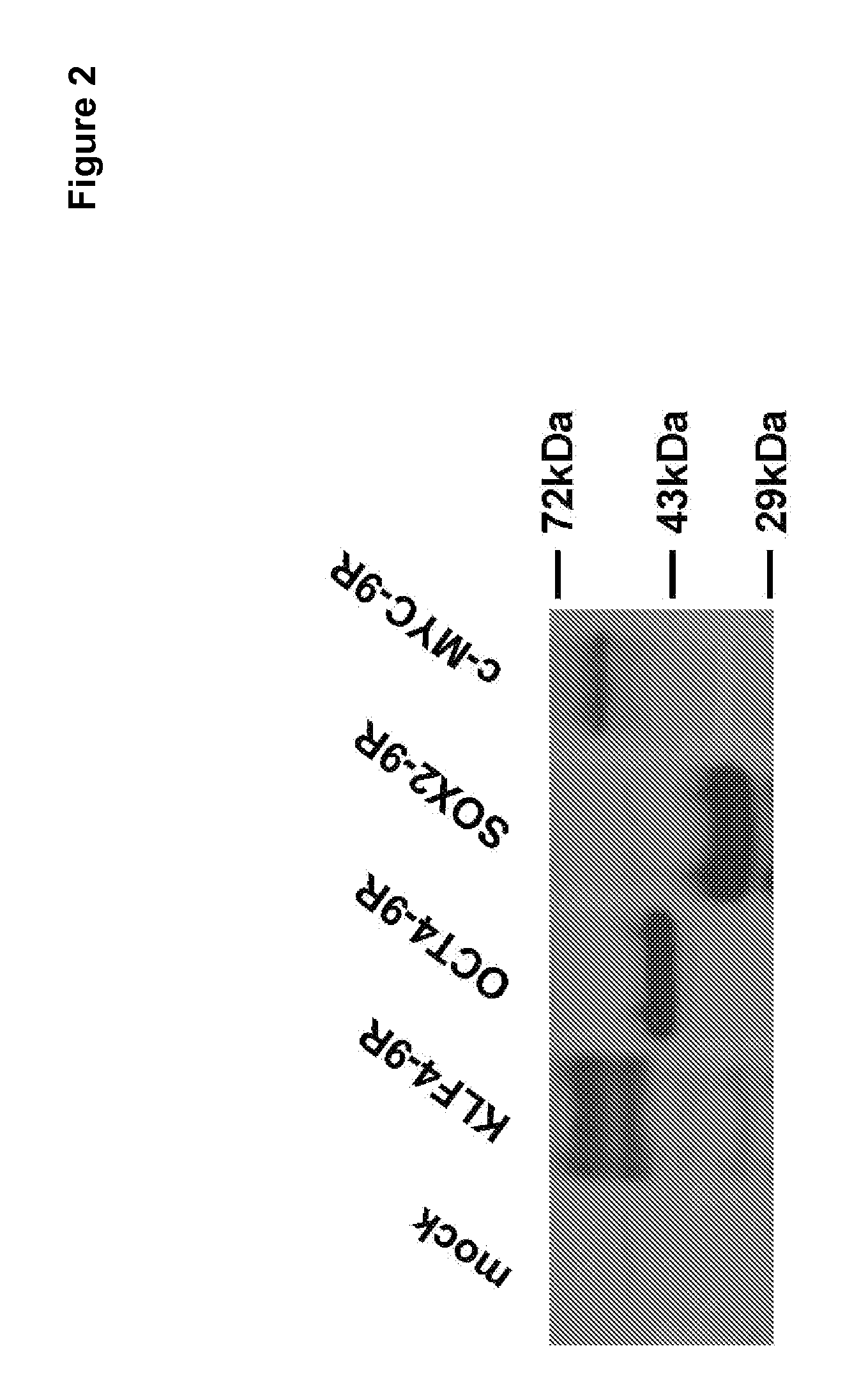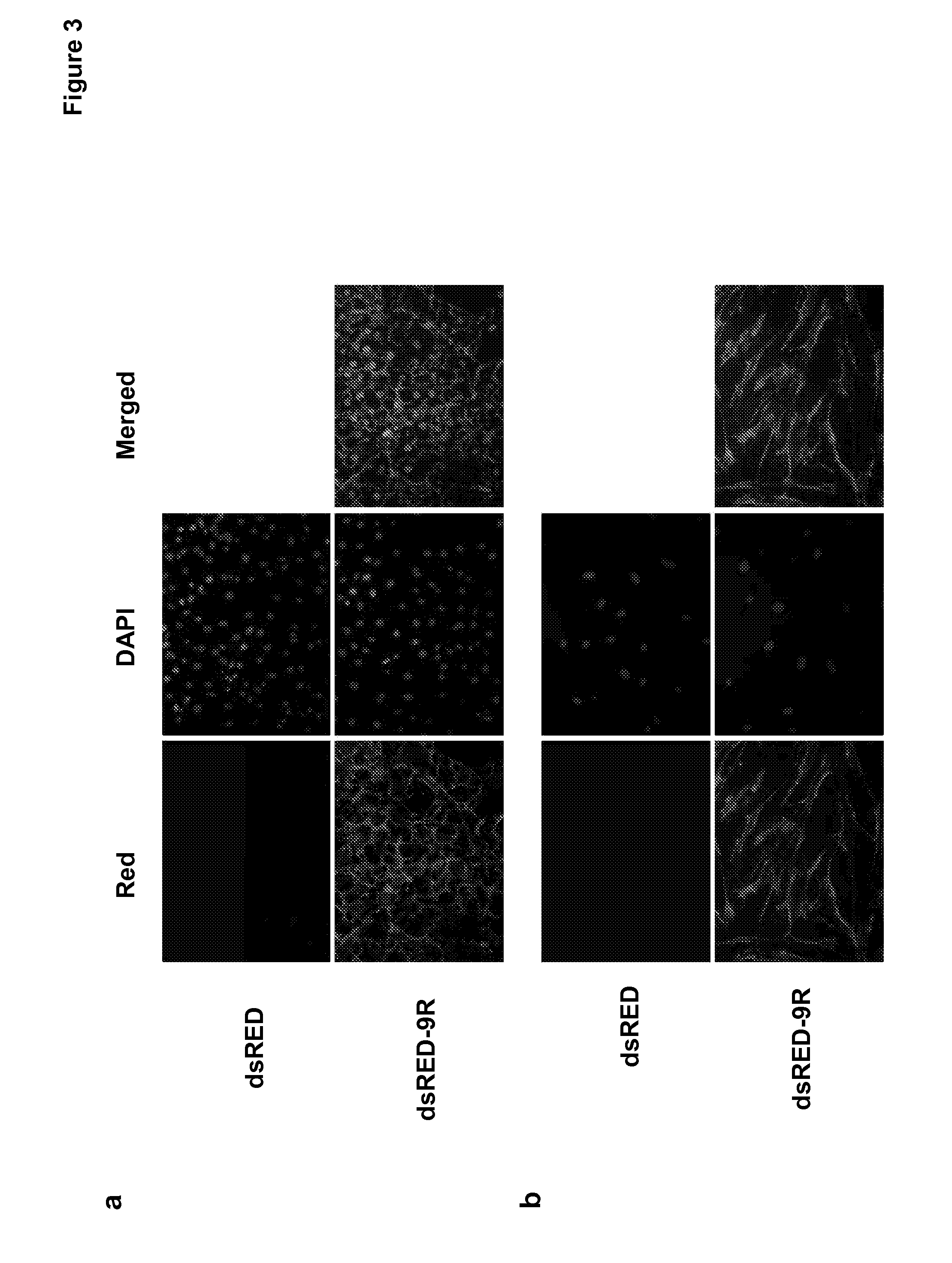Induced pluripotent stem cells
a technology of stem cells and induced pluripotent stem cells, which is applied in the field of production and use of pluripotent cells, can solve the problems of stem cells no longer having the unlimited potential to develop into all cell types, cannot be induced by themselves, and cannot be fetal or adult animals. it is not possible to divide and develop into fetal or adult animals,
- Summary
- Abstract
- Description
- Claims
- Application Information
AI Technical Summary
Benefits of technology
Problems solved by technology
Method used
Image
Examples
example 1
Cell Culture
[0163]Human newborn fibroblasts (HNF) were obtained from ATCC(CCL-117). HNF are cultured with Dulbecco's modified Minimal Essential Medium (DMEM, Invitrogen, Carlsbad, Calif.), supplemented with 2 mM L-glutamine (Invitrogen). 1 mM β-mercaptoethanol, 1× non-essential amino acids (NEAA; Invitrogen, Carlsbad, Calif.), 15% fetal bovine serum (FBS, Sigma-Aldrich, St. Louis, Mo.), 100 U / ml penicillin, 100 μg / ml streptomycin (Invitrogen)
[0164]When cultures were 10-20% confluent, the reprogramming experiment was initiated. Cultures were maintained at 37° C. in 5% CO2, media changes were carried out every other day. For mouse embryonic fibroblast (MEF) isolation, uteri isolated from 13.5-day-pregnant CD1 mice were washed with phosphate-buffered saline (PBS). The head and visceral tissues were removed from isolated embryos. The remaining bodies were washed in fresh PBS, transferred into a 0.1 mM trypsin / 1 mM EDTA solution, and incubated for 20 min. After incubation, MEF culture me...
example 2
Plasmid Construction
[0167]Human cDNAs for OCT4, SOX2, KLF4, and c-MYC were amplified by RT-PCR from human ES poly(A+)RNA using the primers 5′-GGA TCC GAA TTC ATG GCG GGA CAC CTG GCT TCGG-3′ (SEQ ID NO.: 1) and 5′-AAA AAA GTC GAC gcg gcg tct gcg tct gcg gcg tct gcg GTT TGA ATG CAT GGG AGA GCC-3′ (SEQ ID NO.: 2) for human OCT4,5′-GGA TCC GAA TTC ATG TAC AAC ATG ATG GAG ACG G-3′ (SEQ ID NO.: 3) and 5′-AAA AAA CTC GAG gcg gcg tct gcg tct gcg gcg tct gcg CAT GTG CGA CAG GGG CAG TG-3′ (SEQ ID NO.: 4) for human SOX2,5′-GGA TCC GAA TTC ATG GCT GTC AGC GAC GCG CTG C-3′ (SEQ ID NO.: 5) and 5′-AAA AAA CTC GAG gcg gcg tct gcg tct gcg gcg tct gcg AAA GTG CCT CTT CAT GTG TAA GGC-3′ (SEQ ID NO.: 6) for human KLF4, and 5′-GGA TCC GAA TTC ATG CCC CTC AAC GTT AGC TTC AC-3′ (SEQ ID NO.: 7) and 5′-AAA AAA CTC GAG gcg gcg tct gcg tct gcg gcg tct gcg CGC ACA AGA GTT CCG TAG CTG TTC-3′ (SEQ ID NO.: 8) for human c-MYC (underlined nucleotides indicate region encoding the 9× arginines).
[0168]Amplified PCR pr...
example 3
Making Protein Extracts
[0169]HEK 293 cells were maintained in Dulbecco's modified Eagle's medium (DMEM) supplemented with 10% fetal bovine serum containing 100 units / ml penicillin and 100 μg / ml streptomycin. A 2 μg plasmid DNA was transfected to approximately 4×105 cells by Lipofectamine™ (Invitrogen). To establish cells stably expressing 4 factors, 1 / 1000 of cells 48 hours after transfection were seeded and further cultured in the presence of 500 μg / ml neomycin (G418 Sulfate, Clontech, Palo Alto, Calif.). An individual colony was isolated from neomycin-resistant colonies. The expression of 4 factors from neomycin-resistant colonies was determined by Western blot analysis (FIG. 2).
[0170]To prepare cell extracts, cells were washed in PBS and in cell lysis buffer (100 mM HEPES, pH 8.2, 50 mM NaCl, 5 mM MgCl2, 1 mM dithiothreitol, and protease inhibitors), sedimented at 400 g, resuspended in 1 volume of cold cell lysis buffer, and incubated for 30-45 min on ice. Cells were sonicated on...
PUM
| Property | Measurement | Unit |
|---|---|---|
| Morphology | aaaaa | aaaaa |
Abstract
Description
Claims
Application Information
 Login to View More
Login to View More - R&D
- Intellectual Property
- Life Sciences
- Materials
- Tech Scout
- Unparalleled Data Quality
- Higher Quality Content
- 60% Fewer Hallucinations
Browse by: Latest US Patents, China's latest patents, Technical Efficacy Thesaurus, Application Domain, Technology Topic, Popular Technical Reports.
© 2025 PatSnap. All rights reserved.Legal|Privacy policy|Modern Slavery Act Transparency Statement|Sitemap|About US| Contact US: help@patsnap.com



